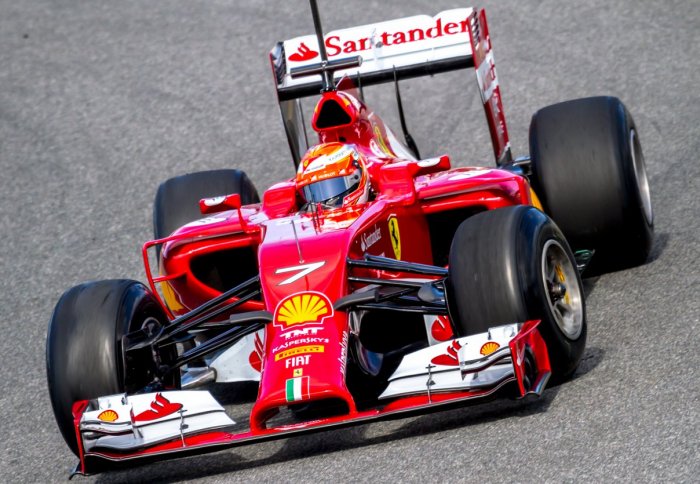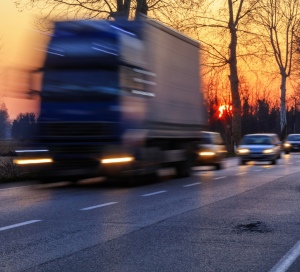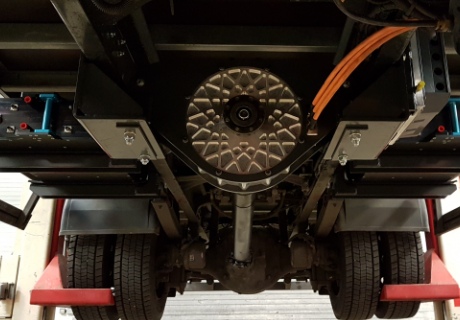F1 tech tested in bid to make trucks more efficient
by Colin Smith

The technology used in Formula One racing to recover energy from braking will be installed in trucks as part of a pilot project.
The aim is for the technology to make heavy goods vehicles, which account for 30 per cent of UK road carbon dioxide emissions, more fuel efficient and environmentally friendly by reducing pollution and noise levels.
The newly formed £2.2 million consortium includes Imperial College London, two logistics operators -Howdens Joinery Co, which manufactures and supplies kitchens, and Sainsbury’s Supermarkets , along with the technology suppliers Alternatech and Adgero. It will trial similar technology used in Formula One vehicles to recover valuable energy to improve how heavy goods vehicles perform in city environments.

New technology could make heavy goods vehicles quieter on urban roads.
Dr Marc Stettler, from the Department of Civil and Environmental Engineering at Imperial College London, said: “There has been a rising awareness and growing number of drivers switching to hybrid and all-electric vehicles. However, the freight industry still relies heavily on diesel combustion engines. It’s vital that we find commercially viable options for the industry that are affordable and have the potential to dramatically reduce the amount of carbon dioxide and air pollutants emitted on our roads. That is why this project is so important.”
The trial will involve the installation of a Kinetic Energy Recovery System (KERS) on 20 heavy goods vehicles used by Sainsbury’s and Howdens to deliver their goods to their stores across the UK.
KERS is used in motorsports such as Formula One Racing and in the World Endurance Championships. Versions of the technology are also used in cars such as the Toyota Prius.
Taking trucks off the road during the day could lead to reduced daytime congestion and that could mean a reduction in emissions hotspots caused by other vehicles
– Dr Marc Stettler
Department of Civil and Environmental Engineering
In congested urban environments vehicles frequently have to stop and start as they move in traffic. This takes a significant amount of energy to accelerate a vehicle each time, especially heavy trucks. With KERS, the energy from a moving vehicle is converted into electricity during the braking phase. This is stored as electricity. It is then used to help the diesel engine accelerate the next time the vehicle moves forward. Using this recycled energy from braking means that less diesel fuel is used.
KERS technology works alongside the combustion engine and consists of an electric motor/generator that is attached to the driveshaft. It can quickly switch between generator mode, in which it generates electricity during braking to slow the vehicle, and motor mode, when it puts power into the driveshaft to help accelerate the vehicle forward.

The KERS technology (above) is fitted to the drive shaft under the heavy vehicle
Ultracapacitors have the advantage of being able to absorb and release energy more rapidly than conventional lithium ion batteries, which is especially important for heavy goods vehicles that need a sudden burst of power.
The scope of the pilot project
The team say that the most important part of the pilot project is to show that the KERS technology is reliable and robust when the trucks are being driven and that it delivers fuel efficiency improvements over comparable diesel trucks.
The partners will be closely monitoring the fuel consumption of the KERS vehicles and comparing the data to standard diesel vehicles that haven’t been fitted with the technology.
During the trial period, they will also conduct measurements of the air pollutant emissions from standard diesel engines and the ones fitted with KERS so they can evaluate whether the system being trialled could help tackle air quality problems in cities.
Technology could curb truck noise emissions
Since the KERS system could reduce the amount of work the diesel engine needs to do, the team will also be quantifying any reduction in noise emissions.
Dr Stettler added: “If we could make heavy goods vehicles quieter in our cities it could have a number of advantages in the way that they are used. For example, a significant noise reduction could them more acceptable to residents living near delivery zones to agree to late night deliveries. Taking trucks off the road during the day could lead to reduced daytime congestion and that could mean a reduction in emissions hotspots caused by other vehicles.”
The consortium will use the data to develop models that they can use to optimise the effectiveness of the KERS and at the end of the project they will share the information with policymakers and the wider road freight industry to encourage adoption of the technology.
This project is funded through the UK Government’s Office for Low Emissions Vehicles and Innovate UK via the Low Emission Freight and Logistics Trial Competition.
Article text (excluding photos or graphics) © Imperial College London.
Photos and graphics subject to third party copyright used with permission or © Imperial College London.
Reporter
Colin Smith
Communications and Public Affairs